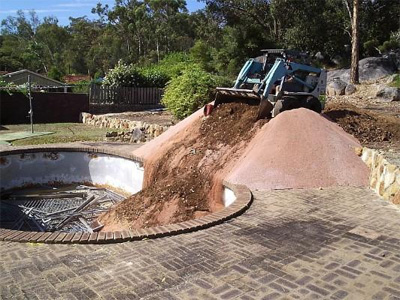Pool Filling
If removing the pool completely is too expensive, we can sometimes fill the the pool in instead.
To start you need to determine the volume of your pool in cubic yards. This is simpler than it sounds. Measure the length, width, and depth of your pool in feet. Multiply each of these numbers, and divide them by 27 (amount of cubic feet in a yard), the number you come up with is the total yardage of your pool. For example if our pool is 30' long, 20' wide’ and 6' deep, it has a total volume of 3,600 square feet (30x20x6). The total square footage divided by 27 is 133.33, this indicates that your pool will need 133.33 cubic yards of material to fill it in.
The water has to be drained out of the pool, of course. Then we a five by five foot hole in the bottom of the pool that gets filled with an aggregate base of crushed rock. This will provide drainage from rainfall or other water after the pool is filled in.

Generally, cities require that the top two feet of the pool walls plus the decking be removed. Often these can be dumped into the hole rather than carrying it away, if the owner agrees to it. Finally, top soil is brought in to cover the site, and the area is graded so that a homeowner can re-landscape.
We will only do the job if the owner signs a waiver removing us from all liability.. The concern is that a homeowner who later sells the home might not disclose to a buyer that a partial pool is still in the backyard.
There might be legal problems if a new owner tries to build something in the backyard like another pool or a villa, for example, and then discovers a carcass of a dead pool underground.
